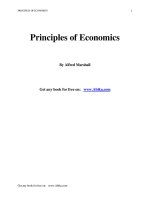Principles of economics openstax chapter6
Bạn đang xem bản rút gọn của tài liệu. Xem và tải ngay bản đầy đủ của tài liệu tại đây (645.48 KB, 21 trang )
College
Principles
ofPhysics
Economics
Chapter
# ChapterChoices
Title
Chapter
6 Consumer
PowerPoint Image Slideshow
Investment in Human capital
Higher education is a good investment regardless of state of the economy.
INVESTMENT IN HUMAN CAPITAL
Those with the highest degrees in 2012 had substantially lower unemployment rates whereas those with the least
formal education suffered from the highest unemployment rates. The national median average weekly income was
$815, and the nation unemployment average in 2012 was 6.8%.
Theory of consumer behavior
The consumer tries to gain the largest possible benefit from goods and services
purchased given a budget constraint.
Maximize Utility
subject to
Budget Constraint
Theory of consumer behavior
Budget Constraint: A limit imposed on household choices by income, wealth, and
product prices.
José has income of $56. Movie pickets cost $7 each and T-shirts cost $14 each. He can
buy 8 movie tickets only, 4 T-shirts only, or any combinations of both that are affordable
like 4 tickets and 2 shirts.
Theory of consumer behavior
Theory of consumer behavior
Equation of the budget constraint can be written
PxX + PyY = I
Px = price of X
X = quantity of X
Py = price of Y
Y = quantity of Y
I = consumer income
THEORY OF CONSUMER BEHAVIOR
The budget constraint will rotate out when price of X falls
THEORY OF CONSUMER BEHAVIOR
The budget constraint will shift out in a parallel manner when consumer income increases.
THEORY OF CONSUMER BEHAVIOR
Total Utility (TU) is the benefit or satisfaction you receive from consuming a good or
service.
Marginal Utility (MU) is the additional satisfaction
gained from consumption an extra unit of a good
or service.
Law of Diminishing Marginal Utility: The more of any
one good consumed, the less satisfaction is received.
MUX declines as you consume more and more X.
THEORY OF CONSUMER BEHAVIOR
Diminishing Marginal Utility
Total Utility and Marginal Utility
Trips
Total
Marginal
to Club
Utility
Utility
1
12
12
2
22
10
3
28
6
4
32
4
5
34
2
6
34
0
THEORY OF CONSUMER BEHAVIOR
The Utility-Maximizing Rule:
In general, utility-maximizing consumers spread out their expenditures until MU per dollar
spent on one good is equal to MU per dollar spent on any other good.
MU X MUY
=
PX
PY
MUx: marginal utility of X
MUy: marginal utility of Y
Px: price of X
Py: price of Y
THEORY OF CONSUMER BEHAVIOR
THEORY OF CONSUMER BEHAVIOR
As the price increases from P0 to P1 to P2 to P3, the budget constraint on the
upper part of the diagram shifts to the left. The utility-maximizing choice
changes from M0 to M1 to M2 to M3. As a result, the quantity demanded of
housing shifts from Q0 to Q1 to Q2 to Q3, ceteris paribus.
The Law of Demand: price and quantity demanded are negatively related.
Demand is downward sloping.
THEORY OF CONSUMER BEHAVIOR
Diminishing Marginal Utility and Downward-Sloping Demand
At price of $40, the utility gained from even first Thai
meal is not worth the price.
At price of $25, Ann and Tom eat Thai meals 5 times a
month.
At price of $15, Ann and Tom will eat Thai meals 10
times a month.
At 25 meals a month, they cannot tolerate the thought
of another Thai meal even if it is free.
E C O N O M I C S I N PRAC TI C E
Substitution and Market Baskets
If we go back to the utility-maximizing rule that you learned
in this chapter, we see Mr. Smith comparing the marginal
utility of each product he consumes relative to its price in
deciding what bundle to buy.
When we restrict Mr. Smith’s ability to substitute goods, we
give him a more expensive bundle.
THE SUPPLY OF LABOR
Households supply labor and business firms demand labor. The
household decision to supply labor depends on:
•
•
•
Availability of jobs
Market wage rates
Skills they possess
THE SUPPLY OF LABOR
Households use the wage rates to decide how much labor to supply and how much
leisure to have.
Substitution Effect: An increase in wage rate will induce households to supply more
labor hours to make extra income. As wage rate increases, the quantity supplied of
labor will rise.
Income Effect: An increase in wage rate will induce households to supply fewer labor
hours in order to have more hours of leisure. As wage rate increases, the quantity
supplied of labor will fall.
THE SUPPLY OF LABOR
The supply of labor in “backward bending” with substitution effect > income effect at modest wage
rates, but income effect > substitution effect at high wage rates.
THE SUPPLY OF CAPITAL
Households savings supply loanable funds.
Business firms demand loanable funds.
The supply and demand for loanable finds determines the rate of interest.
The supply of capital
Personal savings were about 7 to 11% of personal income for most of the years from the late 1950s
to early 1990s. Since then, the rate of personal savings has fallen substantially, although it seems to
have bounced back a bit since 2008.









